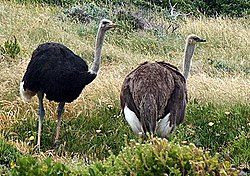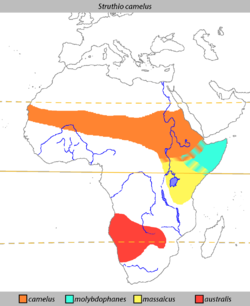පැස්බරා
| පැස්බරා | |
|---|---|
| ගොනුව:පැස්බරා.JPG | |
| පැස්බරා | |
| විද්යාත්මක වර්ගීකරණය |
| Ostrich කාලීන ව්යාප්තිය: Pleistocene to Recent
| |
|---|---|

| |
| Male (left) and female (right) | |
| විද්යාත්මක වර්ගීකරණය | |
| රාජධානිය: | ඇනිමාලියා |
| Phylum: | කෝඩේටා |
| Subphylum: | වර්ටිබ්රේටා |
| වර්ගය: | ආවේස් |
| Superorder: | Paleognathae |
| ගෝත්රය: | Struthioniformes |
| කුලය: | Struthionidae |
| ගණය: | ''Struthio'' |
| විශේෂය: | ''S. camelus'' |
| ද්වීපද නාමය | |
| Struthio camelus | |
| Subspecies | |
|
S. c. australus Gurney, 1868[2] | |

| |
| Distribution | |
පැස්බරා යනු පියෑඹීමට නොහැකි විශාල පක්ෂි විශේෂ කිහිපය අතුරින් එකකට අයත් අප්රිකාව නිජ බිම වූ පක්ෂියෙකි. එසේම ස්ට්රූතියෝ විශේෂය සතු එකම ජීවියා ද වේ. ඇතැම් විශලේෂණයන් පෙන්වා දෙන්නේ සෝමාලියානු පැස්බරා සාමාන්ය පැස්බරාගෙන් වෙන්වූ වෙනමම විශේෂයක් වියයුතු බවයි. නමුත් බොහෝ සත්ත්ව විදයාඥයින් සලකන්නේ උප විශේෂයක් ලෙසය.
order Struthioniformes ට අයත් පක්ෂීන් කිහිප දෙනෙකු වන්නේ කිවි, එමූ, සහ අනිකුත් රැටයිට් (ratite)ය. පැස්බරාගේ බාහිර පෙනුමේ කැපී පෙනෙන ලක්ෂණ වන්නේ, දිගු බෙල්ලක් හා දිගු පාද යුගලකින් සමන්විත වීමයි. මෙම ශක්තිමත් පාද යුගලය නිසාවෙන් 97.5 kilometres per hour (60.6 mph), පමණ වේගයෙන් දිවීමට හැකියාව ලැබී ඇති අතර එය ගොඩබිම පක්ෂියෙකු සතු උපරිම දිවීමේ වේගය ලෙස සැලකේ. [3][4] ගොඩබිම ජීවත් වන විශාලතම පක්ෂියා වන පැස්බරා හට විශාලතම බිත්තරය ද හිමි ය.(වඳවී ගිය පක්ෂීන් වූ මැඩගස්කරයේ elephant bird හා නවසීලන්තයේ (giant moa) යෝධ මෝවා ද විශාල බිත්තර දමනු ලැබීය.
පැස්බරාට ආමාශ තුනක් ඇත.
පෑබරගේ මොලයට වඩා ඇස් විශාල වේ
පැස්බරාගේ ප්රධාන ආහාරය වන්නේ ශාඛ කොටස් වන නමුත් අපෘෂ්ඨවංශික කුඩා සතුන් ද ආහාරයට ගනියි. උන් තැනින් තැන යන කුඩා කණ්ඩායම් ලෙස ජීවත්වන අතර ඊට පහත් පනහත් අතර සංඛයාවක් අයත්වේ. අනතුරකදී පැන දිවීම හෝ සිටින තැනම බිම වැතිරීම උගේ සිරිත වුවද හසුවුවහොත් උගේ ශක්තිමත් පාද වලින් පහරදීමට හැකියාව ඇත. නමුත් Mating patterns differ by geographical region, but territorial males fight for a harem of two to seven females. These fights usually last just minutes, but they can easily cause death through slamming their heads into opponents.
The Ostrich is farmed around the world, particularly for its feathers, which are decorative and are also used as feather dusters. Its skin is used for leather products[5] and its meat marketed commercially.[6]
මූලාශ්ර
[සංස්කරණය]- ^ උපුටාදැක්වීම් දෝෂය: අනීතික
<ref>ටැගය;IUCNනමැති ආශ්රේයන් සඳහා කිසිදු පෙළක් සපයා නොතිබුණි - ^ a b c d e f Brands, S. (2008)
- ^ Doherty, James G. (1974)
- ^ trails.com
- ^ "Ostrich Leather". British Domesticated Ostrich Association. සම්ප්රවේශය 1 March 2011.
- ^ "Ostrich Meat". British Domesticated Ostrich Association. සම්ප්රවේශය 1 March 2011.
- Domesticated birds
- Flightless birds
- Genera of birds
- Heraldic birds
- පශු සම්පත්
- Ratites
- Struthio
- Birds of Africa
- Birds of Angola
- Birds of Botswana
- Birds of Chad
- Birds of Djibouti
- Birds of Eritrea
- Birds of Ethiopia
- Birds of Tunisia
- Birds of Kenya
- Birds of Mali
- Birds of Mauritania
- Birds of Namibia
- Birds of Niger
- Birds of Somalia
- Birds of Sudan
- Birds of Tanzania
- Birds of Uganda
- Birds of Zambia
- Birds of Zimbabwe
- Megafauna of Africa
- Animals described in 1758

